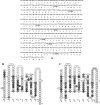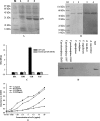Screening for a single-chain variable-fragment antibody that can effectively neutralize the cytotoxicity of the Vibrio parahaemolyticus thermolabile hemolysin
- PMID: 22562997
- PMCID: PMC3416367
- DOI: 10.1128/AEM.00435-12
Screening for a single-chain variable-fragment antibody that can effectively neutralize the cytotoxicity of the Vibrio parahaemolyticus thermolabile hemolysin
Abstract
Vibrio parahaemolyticus is a halophilic bacterium that is widely distributed in water resources. The bacterium causes lethal food-borne diseases and poses a serious threat to human and animal health all over the world. The major pathogenic factor of V. parahaemolyticus is thermolabile hemolysin (TLH), encoded by the tlh gene, but its toxicity mechanisms are unknown. A high-affinity antibody that can neutralize TLH activity effectively is not available. In this study, we successfully expressed and purified the TLH antigen and discovered a high-affinity antibody to TLH, named scFv-LA3, by phage display screening. Cytotoxicity analysis showed that scFv-LA3 has strong neutralization effects on TLH-induced cell toxicity.
Figures






Similar articles
-
[Renaturation of thermolabile hemolysin inclusion bodies expressed by Vibrio parahaemolyticus].Di Yi Jun Yi Da Xue Xue Bao. 2004 Sep;24(9):995-7. Di Yi Jun Yi Da Xue Xue Bao. 2004. PMID: 15447844 Chinese.
-
[Analysis of major phenotypes and hemolysin-related genotypes of Vibrio parahaemolyticus isolates from clinical and seafood samples].Wei Sheng Wu Xue Bao. 2007 Jun;47(3):508-11. Wei Sheng Wu Xue Bao. 2007. PMID: 17672315 Chinese.
-
[Bioinformatic analysis of Vibrio parahaemolyticus thermolabile hemolysin gene].Di Yi Jun Yi Da Xue Xue Bao. 2004 Oct;24(10):1153-5. Di Yi Jun Yi Da Xue Xue Bao. 2004. PMID: 15485788 Chinese.
-
Structure, function and regulation of the thermostable direct hemolysin (TDH) in pandemic Vibrio parahaemolyticus.Microb Pathog. 2018 Oct;123:242-245. doi: 10.1016/j.micpath.2018.07.021. Epub 2018 Jul 19. Microb Pathog. 2018. PMID: 30031890 Review.
-
[Type III secretion system of Vibrio parahaemolyticus--a review].Wei Sheng Wu Xue Bao. 2009 Jul;49(7):848-52. Wei Sheng Wu Xue Bao. 2009. PMID: 19873746 Review. Chinese.
Cited by
-
Effective preparation of a monoclonal antibody against human chromogranin A for immunohistochemical diagnosis.BMC Biotechnol. 2018 May 4;18(1):25. doi: 10.1186/s12896-018-0436-z. BMC Biotechnol. 2018. PMID: 29728076 Free PMC article.
-
Antibody Engineering for Pursuing a Healthier Future.Front Microbiol. 2017 Mar 28;8:495. doi: 10.3389/fmicb.2017.00495. eCollection 2017. Front Microbiol. 2017. PMID: 28400756 Free PMC article. Review.
-
Identification of Two Critical Contact Residues in a Pathogenic Epitope from Tetranectin for Monoclonal Antibody Binding and Preparation of Single-Chain Variable Fragments.Biomolecules. 2025 Jul 30;15(8):1100. doi: 10.3390/biom15081100. Biomolecules. 2025. PMID: 40867545 Free PMC article.
-
The pathogenesis, detection, and prevention of Vibrio parahaemolyticus.Front Microbiol. 2015 Mar 5;6:144. doi: 10.3389/fmicb.2015.00144. eCollection 2015. Front Microbiol. 2015. PMID: 25798132 Free PMC article.
-
The structure of a GFP-based antibody (fluorobody) to TLH, a toxin from Vibrio parahaemolyticus.Acta Crystallogr F Struct Biol Commun. 2015 Jul;71(Pt 7):913-8. doi: 10.1107/S2053230X15008845. Epub 2015 Jun 27. Acta Crystallogr F Struct Biol Commun. 2015. PMID: 26144238 Free PMC article.
References
-
- Barderas R, et al. 2006. A fast mutagenesis procedure to recover soluble and functional scFvs containing amber stop codons from synthetic and semisynthetic antibody libraries. J. Microbiol. Methods 312: 182–189 - PubMed
-
- Bej AK, et al. 1999. Detection of total and hemolysin-producing Vibrio parahaemolyticus in shellfish using multiplex PCR amplification of tl, tdh and trh. J. Microbiol. Methods 36: 215–225 - PubMed
-
- Bresee JS, Widdowson MA, Monroe SS, Glass RI. 2002. Foodborne viral gastroenteritis: challenges and opportunities. Clin. Infect. Dis. 35: 748–753 - PubMed
Publication types
MeSH terms
Substances
LinkOut - more resources
Full Text Sources
Other Literature Sources

